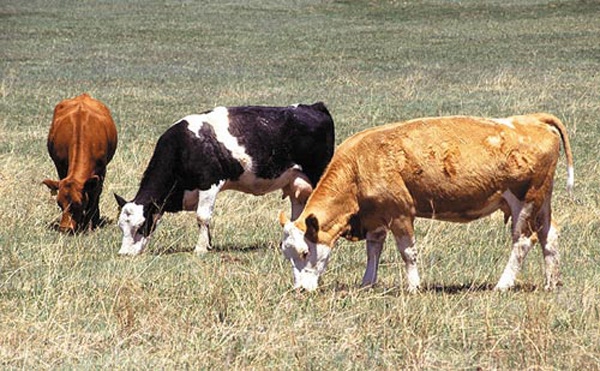September 29, 2012

Drought has cost Arkansas’ beef cattle industry $128 million and the losses may continue to rise, with 3 percent of ranchers saying they planned to sell all their livestock, according to a study released by the University of Arkansas Division of Agriculture.
The study’s authors cautioned that the $128 million figure “should be deemed a conservative estimate of the direct economic impact of the drought on cow-calf producers’ income.” When induced impacts are calculated, the numbers increase to $133 million in labor income losses and a $136 million loss in value added.
The study, “Estimate of Economic Impact of Drought on Commercial Beef Cow/Calf Operations in Arkansas,” is the second phase of the university’s analysis of the drought’s impact. A preliminary report, which also included row crops, was released Aug. 24.
More here.
The study was conducted by Michael Popp, Nathan Kemper, trade adjustment assistance program coordinator for the Southern Risk Management Education Center, and S. Aaron Smith, a Ph.D. student at the University of Arkansas.
For many of Arkansas’ cattle producers, the drought that rekindled in May of this year was an extension of already dry conditions that began during the previous summer. The study covers the period between August 2011 and July 2012.
“It was important to help the beef cattle industry quantify its losses,” said Popp, professor of agricultural economics. “Getting a handle on the reasons and the costs is the first step to helping the industry recover.”
On a ranch level, the loss boils down to $141 per cow. Herd sizes vary widely in Arkansas, from a few head to hundreds, but the average size historically has been about 35 head, Popp said. At that average size, the loss translates to nearly $5,000 per producer.
The researchers limited the scope to immediate economic losses that could be quantified from the survey. Those factors were:
Hay purchases.
Hay prices during the drought rose from what producers reported they would pay in a typical year. “The reported average price for the standard 1,000-pound bale delivered to the farm $37.05 for a typical year and $58.56 this past 12 months,” Popp said.
Hay sales.
Some producers, in addition to raising calves for sale, also sometimes have extra hay for sale. “The selling price for a 1,000-pound bale of hay ready for pickup at the side of the field was reported at $27.52 in a typical year, and $31.52 for the last 12 months.” While the price rose as a result of the drought, quantity sold did decline and producers were about $10 worse off per bred cow on average.
The difference between the purchase and sale price is a function of transportation cost, but should not be used as an estimate of transport cost in this case, because sellers may ship to different markets than where a buyer is obtaining his or her product.
Calf sales.
Producers sustained losses from calf sales in two ways: Weaning early as a result of reduced available forage, and fewer calves, because herd size has decreased given lack of feed in the drought year.
The researchers said additional costs incurred by producers that were not quantifiable from the survey included supplemental feed, transport and purchase of drinking water, and replacement costs incurred when restocking the herd. “These costs vary from farm to farm and can be a significant expense to cow-calf producers,” Popp said.
The drought has also prompted producers to change their herd management. The survey found:
73 percent would sell their calves earlier than in a typical year.
49 percent had reduced their herd size by selling more mature cows than usual.
41 percent planned to sell more mature cows this fall.
41 percent sold replacement heifers that would otherwise replace mature cows.
30 percent said they would sell more replacement heifers this fall.
Other production changes included:
40 percent said they would apply more weed control to allow grasses on pastures to recover better than if weeds were competing.
3 percent said they would sell all their livestock.
76 percent were feeding extra hay and supplements.
18 percent were bringing in water from off-farm sources.
“Longer term cow-calf producer economic losses attributed to the drought, such as pasture recovery, increased breeding failures, reduced heard body condition scores and the impact on agricultural input industries will take additional time to quantify,” Popp said.
Analyses of those longer term effects are subject to ongoing studies.
The $128 million in cow-calf losses also ripple into other industries.
“The health and social services industry experienced the most income and value added losses due to induced impacts,” Kemper said. Those were followed by retail trade, finance and insurance, wholesale trade real estate and rental.
“When cow-calf farmers lose income, that translates into fewer dollars being spent back into the local economy buying groceries and clothes and eating in local restaurants. It also means fewer trips to the doctor and dentist for those farm families,” said Kemper.
The total loss in labor income to those other industries is calculated at $4.4 million. Value added losses were pegged at $8.1 million. “In rural communities where the cow-calf sector makes up an important part of local economic activity, the impacts to main street businesses are substantial.”
During the month of August, surveys were distributed to cow-calf producers who attended drought-production tactics meetings in Hot Springs, Harrison and Quitman, e-mailed to 971 producers through an Animal Science list and another 916 producers on file with the state Department of Agriculture. Researchers received 545 responses from producers in 58 counties. The study results are from 406 usable responses -- those where all the questions were answered -- and the operations encompassed by those surveys accounted for nearly 23,000 bred cows, or approximately 2.5 percent of the cow-calf industry.
The studies are available here and here.
For more information about cattle production or risk management, visit www.uaex.edu or contact your county Extension office.
You May Also Like




